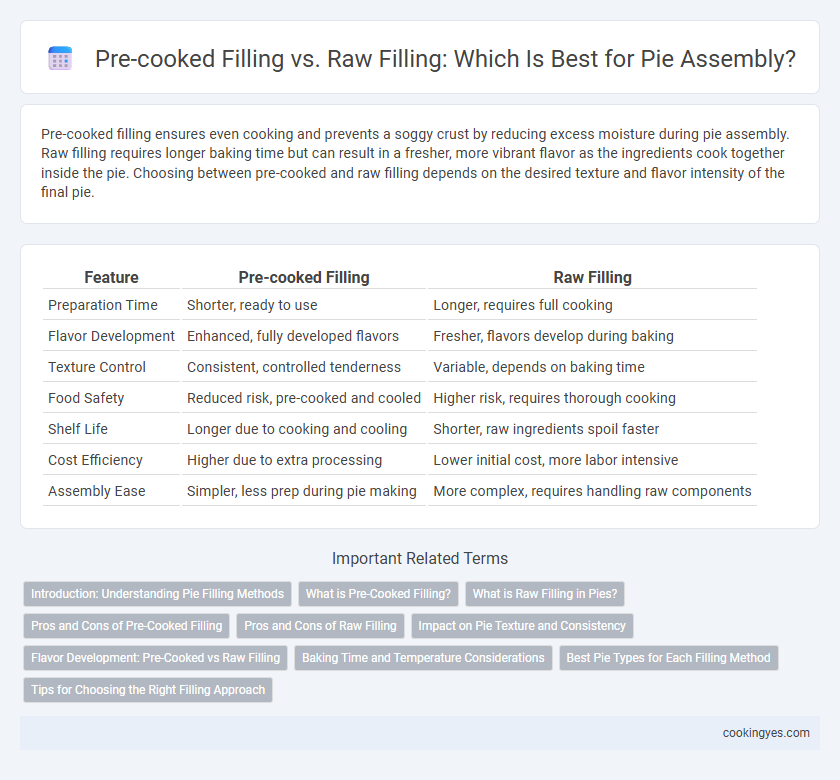Pre-cooked filling ensures even cooking and prevents a soggy crust by reducing excess moisture during pie assembly. Raw filling requires longer baking time but can result in a fresher, more vibrant flavor as the ingredients cook together inside the pie. Choosing between pre-cooked and raw filling depends on the desired texture and flavor intensity of the final pie.
Table of Comparison
| Feature | Pre-cooked Filling | Raw Filling |
|---|---|---|
| Preparation Time | Shorter, ready to use | Longer, requires full cooking |
| Flavor Development | Enhanced, fully developed flavors | Fresher, flavors develop during baking |
| Texture Control | Consistent, controlled tenderness | Variable, depends on baking time |
| Food Safety | Reduced risk, pre-cooked and cooled | Higher risk, requires thorough cooking |
| Shelf Life | Longer due to cooking and cooling | Shorter, raw ingredients spoil faster |
| Cost Efficiency | Higher due to extra processing | Lower initial cost, more labor intensive |
| Assembly Ease | Simpler, less prep during pie making | More complex, requires handling raw components |
Introduction: Understanding Pie Filling Methods
Choosing between pre-cooked filling and raw filling significantly impacts pie texture and flavor. Pre-cooked fillings ensure even cooking and consistent moisture, ideal for fruit and custard pies, while raw fillings offer bolder, fresher flavors but demand precise baking times to avoid undercooked centers. Understanding these methods helps achieve the perfect balance of taste and texture in pie assembly.
What is Pre-Cooked Filling?
Pre-cooked filling refers to pie fillings that have been fully or partially cooked before being assembled into the pie crust, ensuring ingredients are tender and flavors are well-developed. This method reduces baking time and minimizes the risk of an undercooked filling by allowing heat-sensitive components, such as fruits or meats, to reach optimal doneness in advance. Using pre-cooked filling enhances consistency and texture in pies, particularly those with complex ingredient combinations or dense fillings.
What is Raw Filling in Pies?
Raw filling in pies consists of uncooked ingredients such as chopped fruits, sugars, spices, and thickeners that are combined and placed directly into the pie crust before baking. This method allows the filling to cook and thicken inside the pie, resulting in a fresh, vibrant texture and flavor. Raw fillings are commonly used in fruit pies like apple, cherry, and blueberry, where the natural juices meld with the crust during baking.
Pros and Cons of Pre-Cooked Filling
Pre-cooked filling for pie assembly offers consistent texture and reduced baking time since the filling is already cooked, minimizing the risk of undercooked centers. It allows better control over flavor development and moisture levels but can result in a loss of fresh ingredient taste and slightly drier texture compared to raw filling. Using pre-cooked filling also simplifies production in commercial settings, though it requires careful reheating to avoid overcooking or sogginess.
Pros and Cons of Raw Filling
Raw filling in pie assembly offers superior moisture retention and flavor infusion as the ingredients cook together within the pastry, enhancing the overall texture and taste. However, raw filling can lead to uneven baking and increased risk of soggy crusts due to the release of excess liquid during cooking. Choosing raw filling requires careful balancing of ingredient moisture and precise baking times to ensure optimal pie structure and consistency.
Impact on Pie Texture and Consistency
Pre-cooked filling in pie assembly results in a thicker, more uniform texture with reduced moisture migration, preventing sogginess and maintaining structural integrity during baking. Raw filling can lead to a juicier, softer texture but risks excess liquid release that may cause crust sogginess and uneven baking. Selecting pre-cooked fillings enhances consistency and firmness, while raw fillings favor a fresher, more natural taste with potential texture variability.
Flavor Development: Pre-Cooked vs Raw Filling
Pre-cooked pie fillings offer enhanced flavor development due to the Maillard reaction and caramelization occurring during the initial cooking process, resulting in deeper, richer taste profiles. Raw fillings rely on the baking time within the pie crust to cook through, which can cause uneven flavor distribution and sometimes a less intense overall flavor. Using pre-cooked fillings ensures consistent texture and allows spices and ingredients to meld thoroughly before assembling the pie.
Baking Time and Temperature Considerations
Pre-cooked pie fillings require shorter baking times at moderate temperatures, typically around 350degF (175degC) for 30-40 minutes, to heat the filling evenly without overcooking the crust. Raw fillings demand longer baking durations at slightly higher temperatures, often 375degF (190degC) for 45-60 minutes, to ensure the fruit softens and juices thicken properly. Adjusting baking time and temperature based on filling type prevents undercooked centers or burnt pastry edges, optimizing texture and flavor in the final pie.
Best Pie Types for Each Filling Method
Pre-cooked filling is best suited for fruit pies like apple, cherry, and blueberry to prevent soggy crusts and ensure even cooking by fully softening the fruit beforehand. Raw filling works well with custard pies, such as pumpkin, sweet potato, or pecan, allowing the filling to cook slowly and set inside the crust for a smooth, creamy texture. Meat and savory pies benefit from pre-cooked fillings to guarantee thorough cooking and enhanced flavor development without overbaking the crust.
Tips for Choosing the Right Filling Approach
Choosing between pre-cooked filling and raw filling for pie assembly depends on factors like texture, flavor depth, and cooking time. Pre-cooked fillings ensure even heat distribution and help avoid soggy crusts, making them ideal for fruit pies with juicy ingredients such as apples or berries. Raw fillings offer fresher taste and bake directly inside the crust, preferred for simpler recipes like pumpkin or custard pies, where minimal moisture is involved.
Pre-cooked filling vs Raw filling for pie assembly Infographic

 cookingyes.com
cookingyes.com